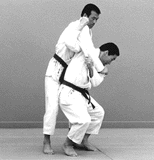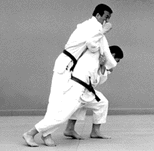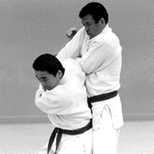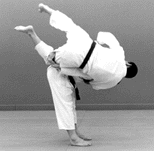sensei stephen class
1. judo style grab - kouchi gari: (don't let thumb grab inside of gi), hand grabbing lapel kinda rolls shoulder back while other pulls in opposite direction, same side leg steps between uke's leg and does a small inner reap, a semi circle with foot close to floor. don't kick leg up when doing reap.
2. judo style grab - step to side ( towards arm grabbing uke's gi @ arm), create side off balance in uke (not forward or backwards, then inside leg steps deep into uke between uke's leg, following leg crosses behind inside leg. keep knees bent. then do inner reap
3. fwd punch - no entry, twist hips, gedan berai but hand is flat and touches uke's belly & arm is almost entirely across uke body, other hand protects face, bend knee for offbalance, lead leg does foot sweep on uke's front/lead leg
4. face punch - hitch step & parry punch, 2 strikes to ribs, hand pushes into low back of uke for offbalance while other arm comes up uke's center line to set up for choke, uke's neck in crook of elbow while same arm's hand catches crook of other elbow, other arm then catches back of uke head. if uke is bigger, make sure feet/legs out of way - so step back, bend knees for take down
6. round house punch - hitch step & block like close the window, inside arm wraps over uke's elbow and snakes to other wrist. inside leg steps back to put knee on floor while this lock bends uke's arm (almost 90 degrees, i think), drop weight to make uke roll forward and land on back, lean into uke w/ side of body while u pull uke arm toward u in same lock. helpful to keep uke arm bent + easier to lay on side w/ ribs up against uke shoulder
7. leg lock from behind: uke wraps legs around your hips from behind while on ground, put own ankles on top of uke's (looks like a yoga position) pressure of own ankles on uke's creates pain in ankle and loosen grip
8. uke is mounted on top grabbing tori's gi - ground defense is to grab uke's arm and send it across body and over opposite shoulder, hands clasp like makin' burgers + applies choke





